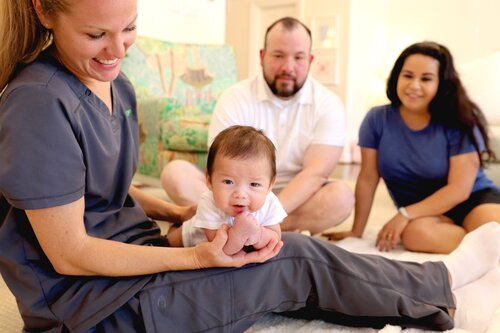Do we need a helmet? Is the head bad enough? At Baby Begin, we get these questions all the time, and there isn’t always an easy answer. Here are a few things to think about that will hopefully lead you in the right direction to treat your baby’s flat head.
First, remember that this is your baby. Looking at head shapes is very subjective. You will probably ask 25 different people about it, and you will probably get 25 different opinions. Some people notice every single irregularity with a head shape. Some (usually the ones who adore the baby the most) don’t see that anything is wrong – the baby is perfect, of course! Some don’t want to tread on shaky ground, so they offer no opinion at all. Others think helmets are horrific and wouldn’t dare think about putting a baby in one. Your doctor may or may not even be a supporter of baby helmers. The opinions go on and on.
When the experts at Baby Begin do a consultation for a head shape, we really try to figure out how the parents feel. We can show you where the flattening is, how much asymmetry there is, and what a “normal” head shape should look like (more on that later). But really, you, as a parent, can determine the best course of action, whether they know it or not. Of course, if the head shape is severe, there is no question – helmeting can correct most of the asymmetries, and it should be done. Moderate deformities make the decision harder, and mild asymmetries are the hardest. We call these our “gray area” babies and really, you could go either way.
Typically, if you see that the ears are not aligned, then they fall into a more moderate severity range. The forehead will probably be flatter on one side, and you may see some volume difference in the cheeks. Milder plagiocephaly is usually just on the back of the head – either on one side or across the entire back half of the head. In the past, we have seen great progress in these cases without baby helmet intervention. This could be hair growth, the head is actually bigger so you notice the flattening less or it has actually rounded out enough to make it look really good. There have been more and more studies trying to determine how much plagiocephaly is actually noticeable once these babies grow up and are in school, but many of the studies have been inconclusive.
The “norms” for head shapes/ratios have changed. Because of back sleeping, skulls are naturally going to be wider than the generations where the babies were side or tummy sleeping. Brachycephaly (flattening across the entire back of the head) is common in these “true back sleepers”. When measured, they appear very wide as it relates to the “norm”. But remember, our norm today is very different from when the old norms were established. So if someone says you need to treat a baby JUST for being wide, question that a little further.
When you go in for a consultation to a baby helmet provider, remember, they are the provider! They are ultimately trying to sell a product. Not to say that, for the most part, they aren’t well intentioned, but they are still the provider. Treating plagiocephaly with helmets is a very profitable business, so be sure to get all of the information and think about it thoroughly – try to keep emotion out of it as much as possible.
When it comes to flat head, if it bothers you now, it’s probably going to bother you next year and probably the next year. If you can afford it, go ahead a get a baby helmet. If, on the other hand, it doesn’t bother you and you are comfortable with the way it looks, then take more time to think about it. You have to go with your gut feeling and often, this helps you make the best decisions. You can’t be influenced by the sales pitch or what your well-intentioned friends say. Ask yourself, “If his/her head looked like this forever, am I comfortable with it?” That will usually give you your answer.
Overall the best case scenario is noticing the flattening early enough so that repositioning and therapy can correct the asymmetries. Don’t sit and watch it get flatter – take action right away. Remember, plagiocephaly is preventable in the first 4-5 months of life.

